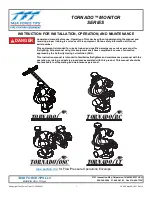
15/112
WL31/WL31TG
2.0 THE WL31 WIRELESS SYSTEM
2.1 MAIN TECHNICAL CHARACTERISTICS
WL31 is a wireless system with totally bi-directional radio communication (Reply
Technology
®
by Elkron).
There are 8 communication channels available using the 433,050-434,790 MHz
frequency band (central frequency 433,920 MHz); the transmission method uses a
narrow band modulation frequency (FSK-NB). The high radio range of the WL31 system
components enables great installation freedom. Thanks to Reply Technology
®
all the
system devices are able to receive and transmit and the control panel always receives
the confirmation that the controls have been received by the other devices.
The level of protection of WL31 system communications is very high and this makes it
suitable also for systems with a medium-high level of security. The supervision time can
be programmed, there is the jamming detection and the exclusive synchronized protocol
(similar to the GSM one) which guarantees immunity from simulations and clever sabotage. This protocol is
dynamic, i.e. it varies over time, it encodes transmissions - which means that it authenticates them - through a 64
bit symmetric double key and it protects from cracks and from code reproductions (playback). The radio channel to
be used is chosen during the installation phase, manually or automatically by the control panel, it is the channel
which allows the best quality for the transmitted signal.
All the WL31 system components are supplied by long lasting lithium batteries (lasting up to three years under
normal condition of use) which make the anti-theft system immune from black-out and disorders of the electrical
network and enable its installation even where there is no electrical network, such as for example on boats,
isolated storehouses, mountain huts, tool sheds or in second houses to avoid having to keep electricity active
during the periods of absence. To keep electricity consumption at low levels, when the system or a single sector is
deactivated the relating volume detectors enter stand-by.
Thanks to the communicators it is possible to remotely manage the whole system - including all the periphery
devices - using the PSTN or GRM telephone networks. It is also possible to locally connect a PC to the control
panel using the RS232 or USB serial port interfaces for a faster configuration.
The following are the main characteristics of the WL31 system:
Simplified acquisition and configuration of the devices by the control panel via radio;
The “Copy” function which enables the transfer, with one single control, of the programming of a device to other
devices of the same family;
The function “Connection test” which enables the check of the efficiency of the radio communication between
the periphery devices to be installed;
The possibility to name (which is to give easily understandable names to) sectors, detectors, sirens, remote
controls, keyboards and management codes. (This is very useful when looking through the event memory)
2.1.1 MAXIMUM SYSTEM DIMENSION AND RELATING EXPANDIBILITY
The system can include:
Up to 32 radio detectors chosen at will among the IR30WL and IRA31WL infrared ones, FO31WL smoke
detectors and the MM30WL magnetic contact ones;
Up to 8 TX30WL and TX31WL radio remote controls;
Up to 4 KP30WL radio keyboards;
Up to 4 HP30WL external radio sirens.
Since the magnetic contact detectors also have two inputs for external auxiliary detectors, which can also be
individually programmed and named, one system can include up to 96 different detectors. Furthermore, the control
panel has two relay inputs and two relay outputs to which more devices can be connected using wires.
















































